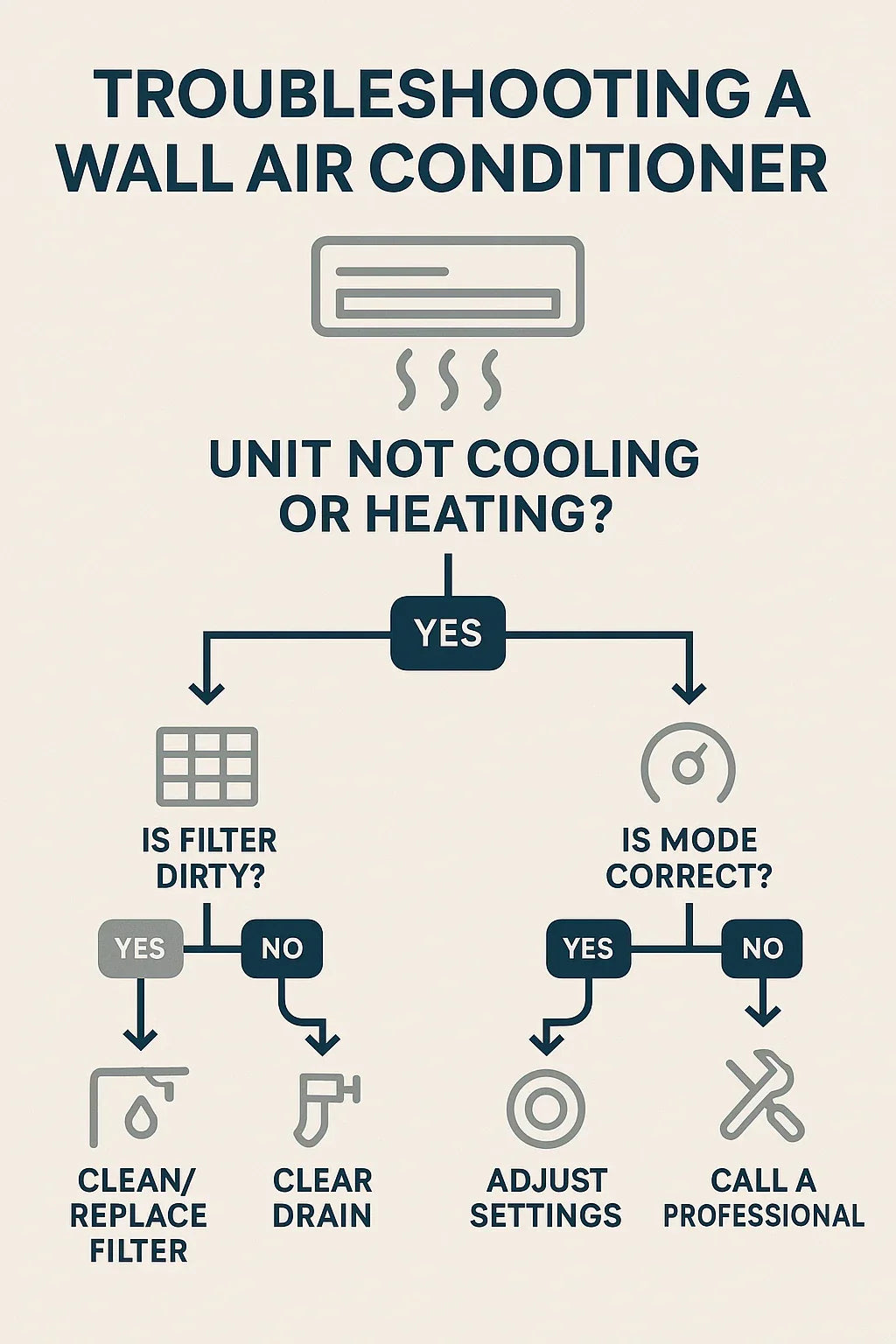Few things are more frustrating than when your heating or cooling unit suddenly stops doing its job. Whether it’s the middle of a hot summer or a chilly winter night, finding your Amana, GE, or Hotpoint wall unit blowing the wrong temperature—or nothing at all—can feel overwhelming.
But here’s the good news: many of the most common problems are easy to troubleshoot yourself before calling in a professional. In this guide, I’ll walk you through the step-by-step process I use whenever a unit isn’t heating or cooling, plus brand-specific tips for Amana, GE, and Hotpoint models.
🔌 Step 1: Start with the Basics
Before you assume the worst, check the simplest issues first:
-
Power supply
-
Confirm the unit is plugged in.
-
Test the outlet with another appliance.
-
For 230V models, make sure the breaker hasn’t tripped.
-
-
Remote or thermostat
-
Replace remote batteries.
-
Verify the thermostat is set correctly (cooling vs. heating mode).
-
-
Reset the unit
-
Many units have a reset button—press and hold for 3–5 seconds.
-
Alternatively, unplug the unit for 1 minute and plug back in.
-
👉 GE’s troubleshooting page recommends a simple reset before calling service, as it resolves many issues .
🌬️ Step 2: Airflow Issues
Poor airflow is one of the most common culprits.
-
Filters
-
A dirty filter can block airflow and cause poor heating or cooling.
-
Clean monthly; replace if damaged.
-
-
Vents & ducts (if applicable)
-
Ensure furniture isn’t blocking the unit’s airflow.
-
For PTACs, check both intake and exhaust areas.
-
-
Fan operation
-
Listen for the fan—if it isn’t spinning, the motor may be faulty.
-
👉 According to the DOE, dirty filters alone can increase energy use by 15% and make units seem like they aren’t working.
💧 Step 3: Drain & Moisture Problems
When your unit isn’t draining properly, it can lead to water leaks, mold, or even ice buildup—all of which impact performance.
-
Drain pan
-
Look underneath—if it’s overflowing, the drain line is clogged.
-
-
Condensate line
-
Flush with a mix of vinegar and water.
-
-
Ice on coils
-
Indicates blocked airflow or low refrigerant. Turn the unit off and let it thaw.
-
💡 Amana models are known for sturdy drain pans, but still need regular checks. GE’s angled drain design reduces clogs, while Hotpoint units often require more frequent attention.
❄️ Step 4: Cooling-Specific Problems
If your unit turns on but doesn’t cool, here’s what to check:
-
Mode settings
-
Confirm the unit is actually in cooling mode.
-
-
Coils
-
Dirty evaporator or condenser coils block heat transfer.
-
Vacuum annually, or have them professionally cleaned.
-
-
Refrigerant
-
If cooling is weak even with clean filters and coils, refrigerant may be low.
-
Only an HVAC pro can recharge the system.
-
-
Compressor
-
Listen for clicking but no hum—this could indicate a bad compressor.
-
👉 The EnergyStar AC troubleshooting guide stresses that refrigerant work is not DIY and should always be left to certified technicians.
🔥 Step 5: Heating-Specific Problems
For units with electric heat kits or heat pumps, issues can include:
-
Electric heat kits
-
Check the circuit breaker.
-
If the coils don’t glow, the kit may need replacement.
-
-
Heat pumps
-
In cold climates, heat pumps can struggle below 30°F.
-
Make sure defrost mode is working.
-
-
Thermostat settings
-
Some GE and Amana models allow switching between “electric heat” and “heat pump” modes.
-
💡 Hotpoint heating performance is usually electric resistance only—so if it isn’t heating, the issue is likely electrical.
🛠️ Step 6: Brand-Specific Tips
🔴 Amana
-
Known for durability, but regular filter and drain checks are key.
-
Strong warranty coverage—don’t hesitate to use it if major issues arise.
🔵 GE
-
Many models include smart error codes—pay attention to flashing lights or digital displays.
-
Quieter than most brands, so odd noises (rattling, humming) should be investigated quickly.
⚪ Hotpoint
-
Basic models mean fewer features but more hands-on upkeep.
-
Filters and coils clog faster—monthly checks are a must.
👉 Check your unit’s model manual at GE Appliances Support
🚫 When to DIY vs. Call a Pro
✅ Safe DIY Fixes
-
Resetting the unit
-
Cleaning/replacing filters
-
Flushing drains
-
Cleaning coils
-
Checking thermostat settings
🚫 Professional Help Needed
-
Refrigerant recharge
-
Compressor replacement
-
Electrical failures
-
Persistent leaks after cleaning
👉 Use ACCA’s contractor search to find licensed professionals near you.
🧾 Cost of Common Repairs
| Issue | DIY Fix? | Pro Cost Range |
|---|---|---|
| Dirty filter | ✅ | $10–$40 |
| Clogged drain line | ✅ | $75–$150 |
| Coil cleaning | ✅ (light) / Pro for deep clean | $100–$300 |
| Refrigerant recharge | 🚫 | $200–$500 |
| Compressor replacement | 🚫 | $700–$1,200 |
| Electric heat kit swap | 🚫 | $200–$400 |
💡 Takeaway: A little maintenance goes a long way. Most issues are cheap to fix if caught early.
📝 Samantha’s Final Thoughts
The first time my Amana stopped cooling, I panicked. But after pulling the filter out and seeing it was coated in dust, I realized the problem was simple. That experience taught me that most “big” problems start with small maintenance lapses.
Here’s my rule of thumb:
-
Start simple. Check filters, drains, and settings.
-
Look for signs. Ice = airflow or refrigerant. No heat = electrical or mode issue.
-
Know your limits. Anything involving refrigerant or wiring is pro-only.
If you own an Amana, GE, or Hotpoint unit, following this troubleshooting guide will save you time, money, and frustration—and keep your home comfortable year-round.
In the next topic we will know more about: Energy Efficiency Face-Off: Which Brand Saves You More on Utilities?







